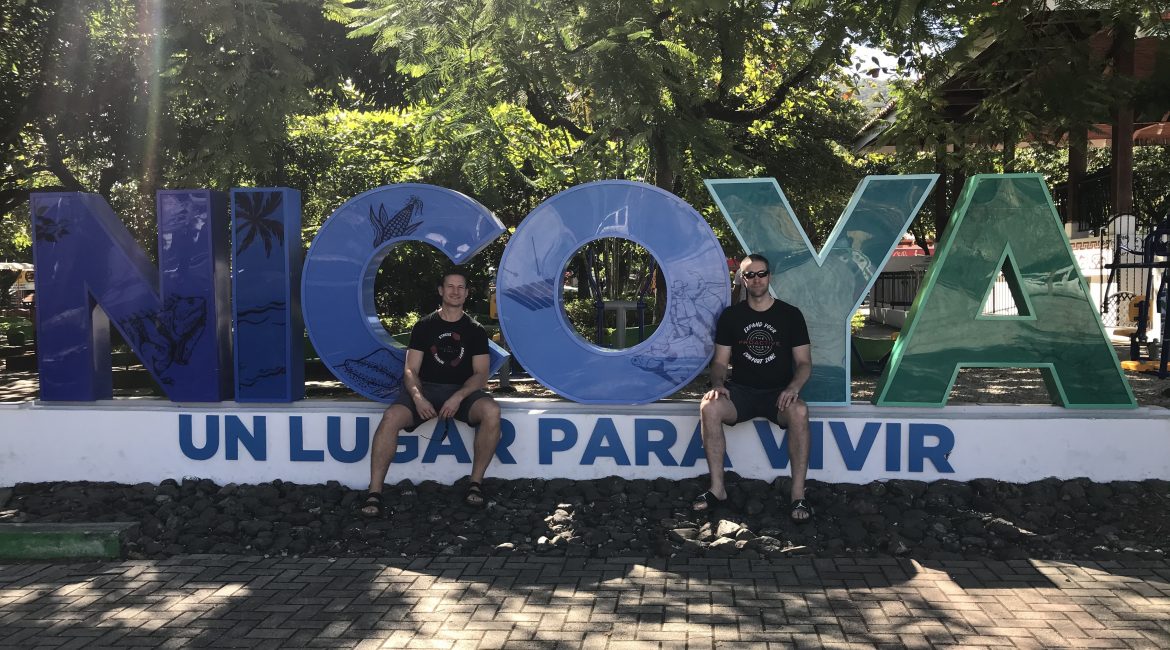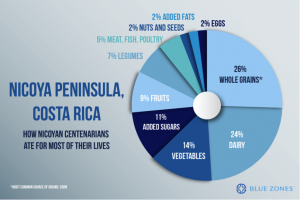Nicoya, Costa Rica Secrets to longevity

You may have noticed Pete and I are writing more on longevity lately. Life seems to be moving fast for both of us, accelerating us towards that next decade mark. You know the saying…time flies when you’re having fun. And we want the fun to continue, for many, many years to come. If you are reading this, you too likely share that goal, and we welcome you to join us in our pursuit of living a robust life to 100 and beyond!!
Hope and optimism are important, but what can we do to make those long odds become more probable?
Let’s look to those who are seemingly already aging successfully and enjoying long healthy lives. This is the blackbox approach that Dan Buettner, National Geographic journalist has dedicated his career to, first publishing a book in 2010 called The Blue Zones, lessons for living longer.
If you have heard of the term Blue Zones this is entirely Dan’s doing. He and his team identified 5 regions of the world that have documented a high proportion of centenarians and are generally regarded as longevity hotspots, which he calls Blue Zones. The blue zones are Sardinia Italy, Okinawa Japan, Loma Lisa California, Nicoya Costa Rica and Ikaria Greece.
Pete and I recently had the opportunity to visit and explore one of these Blue Zones, the Nicoya region in Costa Rica. In this region middle-age people reach a healthy 90 at rates up to 2.5 times greater than those in the US! So what’s the secret?
Social networks
Dan and his team of demographers, scientists and anthropologist experts conclude a strong faith in community, with deep social networks is at the root. In the city of Nicoya Pete and I witnessed a buzz of community activity surrounding city parks, churches, the library and in café’s lining the streets…all on a Monday morning. There was a community group setting up for an event in a central square with artisan vendors and several signs posted highlighting festivals held there, including an annual event celebrating their seniors and centenarians. Small sample of observations, but no shortage of examples to verify this conclusion.
Plan de vida
In the book Dan describes a plan de vida, a sense of purpose and value these centenarians have. When we ventured out in Nicoya we had low expectations of finding anything that signified this. As we wondered in this public square and engaged with some locals, we were directed toward a 500 plus year-old church at the edge of the city square. And there it was. A living shrine. An art like gallery highlighting all the region’s centenarians. We counted 55, yes 55!!, featured centenarians, some of which were riding horses, playing the guitar or joyfully cooking in the kitchen. Each of them radiated happiness, a sense of enthusiasm really, with their apparent value in their community. Their plan de vida, ‘why I wake up in the morning’ seemed quite apparent as an ongoing inspiration for the rest of the community. It was impossible to be amongst that display and not be inspired.
Diet of Whole, unprocessed (mostly plant) food
Nicoyian’s have typically eaten diets high in grains, dairy and vegetables (although a lower percentage of vegetables compared to other blue zone regions). Check out the Nicoya dietary pie chart breakdown below. If you are keto, paleo or otherwise adhere to a low carb diet, this might not strike you as an optimal breakdown. However, of comparable interest the Okinawan’s were also known to rely heavily on starchy carbohydrates, mostly sweet potatoes which were reported to have made up to 70% of their diet. It’s quite likely their historically active lifestyles, including growing their own gardens and raising livestock without the mechanical conveniences for their house and yard work helped minimize the impact of a moderate to higher carb diet.

Most nutrition experts would argue we should strive for much more than 14% of our diet from vegetables these days. But the main take home lesson here from a Nicoyan diet is that focusing on whole, unprocessed foods is of much greater importance to longevity than their specific proportions.
From our personal experience we returned craving brown rice and black beans. Simple, but a nutritious, low cost dynamic duo high in fibre and many minerals. When combined they pack a full protein punch with all the essential amino acids required for protein synthesis.
We had to keep an eye out on the roads for those free ranging chickens and casually grazing cows. Gotta love that these chickens are free to search out nutrition far beyond a sterile coop with a grain only diet. And the result is eggs a plenty. Rows and rows of cartons stacked higher than our heads in local grocery stores, all with beautiful bright orange yolk. No comparison to the dull yellow nutrient deficient egg yolks often found in our grocery stores. And to boot, they were only half the cost of what we usually pay at home. We definitely ate more than our quota of eggs!!
One local tradition that is unforgettable is the cooked corn tortillas. Unreal. Costa ricans (and Okinawan’s) are known to soak their corn overnight with water and lime, which makes the corn more digestible with higher amino acid bioavailability and infuses them with higher concentrations of calcium. (On a similar note the Nicoyan water is high in calcium due to the limestone bedrock and in combination with abundant availability of Vitamin D from sunlight is thought to contribute to their longevity through healthier bones.)
Rice, beans, eggs, corn tortillas…maybe won’t satisfy some travelling ‘foodies’, but I miss the wholesome simplicity already.
Other common aspects of all the blue zones:
–Downshifting: de-stressing through reflection of ancestors, prayer, napping or happy hour
–80% rule: stop eating before you are full
–plant slant: meat is eaten on average only 5 times per month and serving sizes are 3 to 4 oz, about the size of a deck of cards
–moderate and regular alcohol intake: one to 2 glasses of wine per day with friends and/or with food
–belong: all but 5 of the 263 centenarians interviewed belonged to some faith-based community, denomination did not seem to matter
–loved ones first: Aging parents and grandparents stay in the home. Commit to a life partner. Invest in children with time and love.
Pura Vida!
